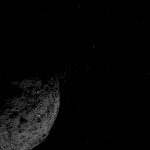
The first close-up observations by the OSIRIS-REx spacecraft of its target, asteroid Bennu, reveal new details that pose a bigger challenge than scientists expected to the mission’s objective of collecting a sample of the asteroid.
The OSIRIS-REx (Origins, Spectral Interpretation, Resource Identification, Security-Regolith Explorer) spacecraft reached Bennu on December 3, 2018 after traveling 1.4 million miles (2.2 million km). For the past three months, OSIRIS-REx has been investigating Bennu at close range, beginning to search for an ideal site to collect a sample, and getting to know the asteroid in much greater detail.
While the spacecraft’s observations have confirmed many of the measurements obtained by ground-based observations, recent findings have revealed that Bennu is a more challenging target than what the mission was originally designed for.
Here are some key findings from mission team members, presented at the Lunar and Planetary Sciences Conference in Houston on March 19, 2019.
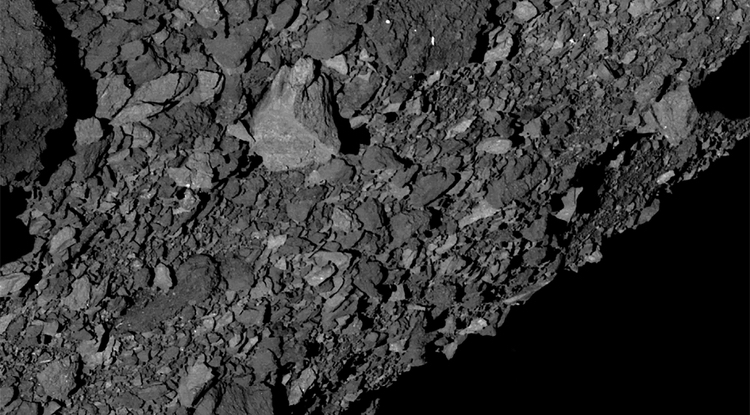
Bennu’s surface is rockier than expected, creating challenges for the team whose mission is to scoop up a sample of pristine material and return it to Earth in 2023. Image via NASA/Goddard/University of Arizona.
Big boulders on Bennu’s surface
The OSIRIS-REx team developed its sampling strategy around what they knew about Bennu when they designed the mission. They anticipated plentiful patches of relatively smooth surface with gravel and pebbles less than 1 inch in size that expand over at least 55 yards (50 meters). Instead, the spacecraft observed only a small number of regions, each between 5.4 and 22 yards (5 and 20 m), that are devoid of large boulders that pose a hazard to the spacecraft when it touches down to collect its sample.
This trio of images was taken by the OSIRIS-REx spacecraft on February 25, 2019, in orbit around Bennu, about 1.1 miles (1.8 km) from the asteroid’s surface. The images show a wide shot and 2 close-ups of a region in Bennu’s northern hemisphere. Image via NASA/Goddard/University of Arizona.
… make for a terrible airfield
Instead of having the equivalent of half a football field to navigate in, the spacecraft will have to operate within the confines of sampling sites that are half the size of a basketball court or smaller.
High-resolution images made with the OSIRIS-REx cameras, reveal a surface packed with more than 200 boulders larger than 33 feet (10 m) in diameter and many more that are 3 feet (1 m) or larger. The largest boulder measures 63 yards (58 m) across.
Bennu is very dark
OSIRIS-REx measurements also confirm that Bennu is one of the darkest objects in the solar system, reflecting only 4 percent of sunlight. One of the surprises turned out to be a larger-than-expected variability in surface albedo, the proportion of light reflected by a surface. In other words, Bennu’s surface features vary greatly from one another with respect to their brightness. The high variability in albedo presents a challenge for the laser of the spacecraft’s lidar system, designed to guide the sample acquisition approach.
These findings were published in the journal Nature on March 19, 2019.
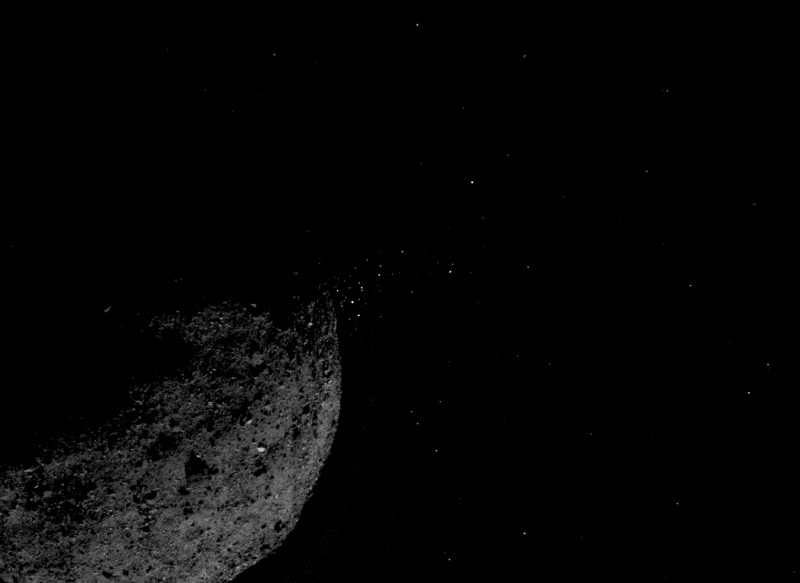
This view of asteroid Bennu ejecting particles from its surface on January 19, 2019, was created by combining 2 images taken on board the OSIRIS-REx spacecraft. Image via NASA/Goddard/University of Arizona/Lockheed Martin.
Another surprise … particle plumes!
In another strange discovery, OSIRIS-REx observes plumes of particles being energetically ejected from the surface of Bennu. It’s the first-ever close-up observations of particle plumes erupting from an asteroid’s surface.
The OSIRIS-REx team first spotted the particle plumes in images while the spacecraft was orbiting Bennu at a distance of about one mile (1.61 km). The mission team did a safety assessment and concluded the particles did not pose a risk to the spacecraft. The team continues to analyze the particle plumes and their possible causes. Read more about the discovery from NASA
Dante Lauretta is OSIRIS-REx principal investigator at the University of Arizona. Lauretta said in a statement:
The discovery of plumes is one of the biggest surprises of my scientific career. And the rugged terrain went against all of our predictions. Bennu is already surprising us, and our exciting journey there is just getting started.
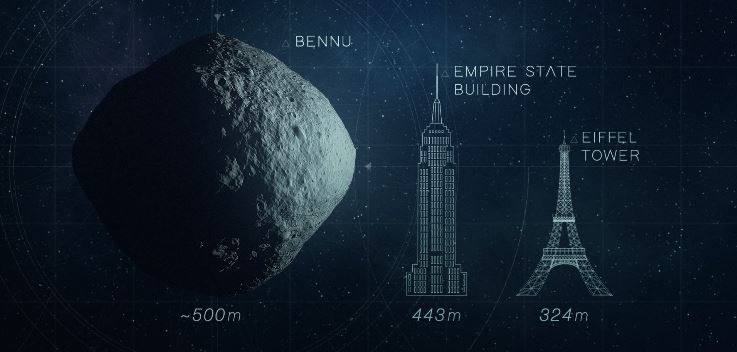
The size of asteroid Bennu, which is 1,614 feet (492 meters) wide, compared with the Empire State Building and the Eiffel Tower in this NASA image.
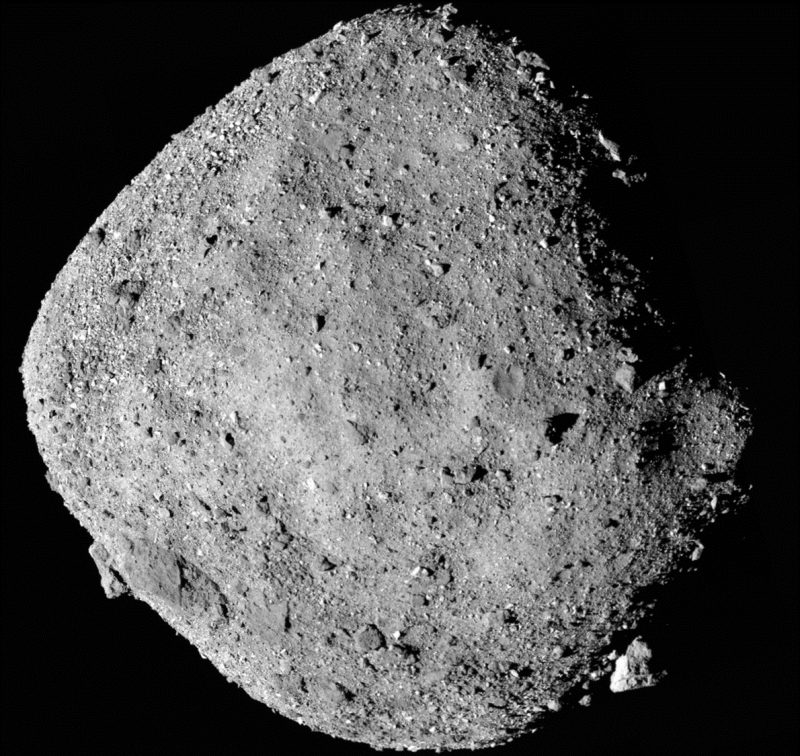
The OSIRIS-REx spacecraft was only 15 miles (24 km) from asteroid Bennu – on December 2, 2018 – when it captured the 12 high-resolution images that make up this mosaic. The mosaic shows features as small as 20 feet (6 meters). Image via NASA/Goddard/University of Arizona.
Bottom line: New findings about asteroid Bennu from the OSIRIS-REx mission.
from EarthSky https://ift.tt/2JSkYB9

The first close-up observations by the OSIRIS-REx spacecraft of its target, asteroid Bennu, reveal new details that pose a bigger challenge than scientists expected to the mission’s objective of collecting a sample of the asteroid.
The OSIRIS-REx (Origins, Spectral Interpretation, Resource Identification, Security-Regolith Explorer) spacecraft reached Bennu on December 3, 2018 after traveling 1.4 million miles (2.2 million km). For the past three months, OSIRIS-REx has been investigating Bennu at close range, beginning to search for an ideal site to collect a sample, and getting to know the asteroid in much greater detail.
While the spacecraft’s observations have confirmed many of the measurements obtained by ground-based observations, recent findings have revealed that Bennu is a more challenging target than what the mission was originally designed for.
Here are some key findings from mission team members, presented at the Lunar and Planetary Sciences Conference in Houston on March 19, 2019.

Bennu’s surface is rockier than expected, creating challenges for the team whose mission is to scoop up a sample of pristine material and return it to Earth in 2023. Image via NASA/Goddard/University of Arizona.
Big boulders on Bennu’s surface
The OSIRIS-REx team developed its sampling strategy around what they knew about Bennu when they designed the mission. They anticipated plentiful patches of relatively smooth surface with gravel and pebbles less than 1 inch in size that expand over at least 55 yards (50 meters). Instead, the spacecraft observed only a small number of regions, each between 5.4 and 22 yards (5 and 20 m), that are devoid of large boulders that pose a hazard to the spacecraft when it touches down to collect its sample.
This trio of images was taken by the OSIRIS-REx spacecraft on February 25, 2019, in orbit around Bennu, about 1.1 miles (1.8 km) from the asteroid’s surface. The images show a wide shot and 2 close-ups of a region in Bennu’s northern hemisphere. Image via NASA/Goddard/University of Arizona.
… make for a terrible airfield
Instead of having the equivalent of half a football field to navigate in, the spacecraft will have to operate within the confines of sampling sites that are half the size of a basketball court or smaller.
High-resolution images made with the OSIRIS-REx cameras, reveal a surface packed with more than 200 boulders larger than 33 feet (10 m) in diameter and many more that are 3 feet (1 m) or larger. The largest boulder measures 63 yards (58 m) across.
Bennu is very dark
OSIRIS-REx measurements also confirm that Bennu is one of the darkest objects in the solar system, reflecting only 4 percent of sunlight. One of the surprises turned out to be a larger-than-expected variability in surface albedo, the proportion of light reflected by a surface. In other words, Bennu’s surface features vary greatly from one another with respect to their brightness. The high variability in albedo presents a challenge for the laser of the spacecraft’s lidar system, designed to guide the sample acquisition approach.
These findings were published in the journal Nature on March 19, 2019.

This view of asteroid Bennu ejecting particles from its surface on January 19, 2019, was created by combining 2 images taken on board the OSIRIS-REx spacecraft. Image via NASA/Goddard/University of Arizona/Lockheed Martin.
Another surprise … particle plumes!
In another strange discovery, OSIRIS-REx observes plumes of particles being energetically ejected from the surface of Bennu. It’s the first-ever close-up observations of particle plumes erupting from an asteroid’s surface.
The OSIRIS-REx team first spotted the particle plumes in images while the spacecraft was orbiting Bennu at a distance of about one mile (1.61 km). The mission team did a safety assessment and concluded the particles did not pose a risk to the spacecraft. The team continues to analyze the particle plumes and their possible causes. Read more about the discovery from NASA
Dante Lauretta is OSIRIS-REx principal investigator at the University of Arizona. Lauretta said in a statement:
The discovery of plumes is one of the biggest surprises of my scientific career. And the rugged terrain went against all of our predictions. Bennu is already surprising us, and our exciting journey there is just getting started.

The size of asteroid Bennu, which is 1,614 feet (492 meters) wide, compared with the Empire State Building and the Eiffel Tower in this NASA image.

The OSIRIS-REx spacecraft was only 15 miles (24 km) from asteroid Bennu – on December 2, 2018 – when it captured the 12 high-resolution images that make up this mosaic. The mosaic shows features as small as 20 feet (6 meters). Image via NASA/Goddard/University of Arizona.
Bottom line: New findings about asteroid Bennu from the OSIRIS-REx mission.
from EarthSky https://ift.tt/2JSkYB9

Aucun commentaire:
Enregistrer un commentaire